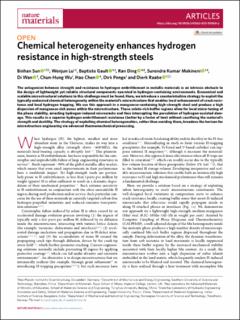| dc.contributor.author | Sun, Binhan | |
| dc.contributor.author | Lu, Wenjun | |
| dc.contributor.author | Gault, Baptiste | |
| dc.contributor.author | Ding, Ran | |
| dc.contributor.author | Makineni, Surendra Kumar | |
| dc.contributor.author | Wan, Di | |
| dc.contributor.author | Wu, Chun-Hung | |
| dc.contributor.author | Chen, Hao | |
| dc.contributor.author | Ponge, Dirk | |
| dc.contributor.author | Raabe, Dierk | |
| dc.date.accessioned | 2021-09-29T07:25:20Z | |
| dc.date.available | 2021-09-29T07:25:20Z | |
| dc.date.created | 2021-07-09T10:34:06Z | |
| dc.date.issued | 2021 | |
| dc.identifier.issn | 1476-1122 | |
| dc.identifier.uri | https://hdl.handle.net/11250/2785877 | |
| dc.description.abstract | The antagonism between strength and resistance to hydrogen embrittlement in metallic materials is an intrinsic obstacle to the design of lightweight yet reliable structural components operated in hydrogen-containing environments. Economical and scalable microstructural solutions to this challenge must be found. Here, we introduce a counterintuitive strategy to exploit the typically undesired chemical heterogeneity within the material’s microstructure that enables local enhancement of crack resistance and local hydrogen trapping. We use this approach in a manganese-containing high-strength steel and produce a high dispersion of manganese-rich zones within the microstructure. These solute-rich buffer regions allow for local micro-tuning of the phase stability, arresting hydrogen-induced microcracks and thus interrupting the percolation of hydrogen-assisted damage. This results in a superior hydrogen embrittlement resistance (better by a factor of two) without sacrificing the material’s strength and ductility. The strategy of exploiting chemical heterogeneities, rather than avoiding them, broadens the horizon for microstructure engineering via advanced thermomechanical processing. | en_US |
| dc.language.iso | eng | en_US |
| dc.publisher | Nature Research | en_US |
| dc.rights | Navngivelse 4.0 Internasjonal | * |
| dc.rights.uri | http://creativecommons.org/licenses/by/4.0/deed.no | * |
| dc.title | Chemical heterogeneity enhances hydrogen resistance in high-strength steels | en_US |
| dc.type | Journal article | en_US |
| dc.type | Peer reviewed | en_US |
| dc.description.version | publishedVersion | en_US |
| dc.source.journal | Nature Materials | en_US |
| dc.identifier.doi | 10.1038/s41563-021-01050-y | |
| dc.identifier.cristin | 1921125 | |
| cristin.ispublished | true | |
| cristin.fulltext | original | |
| cristin.qualitycode | 2 | |

